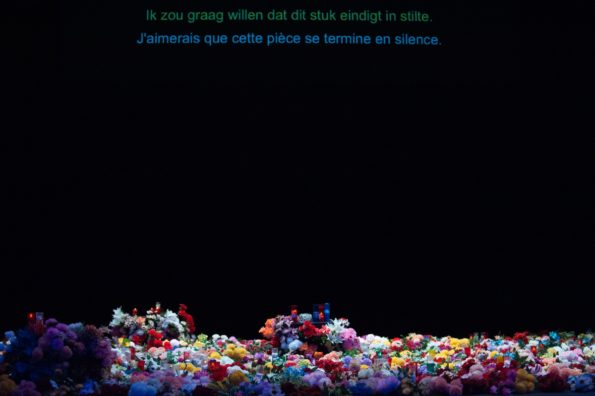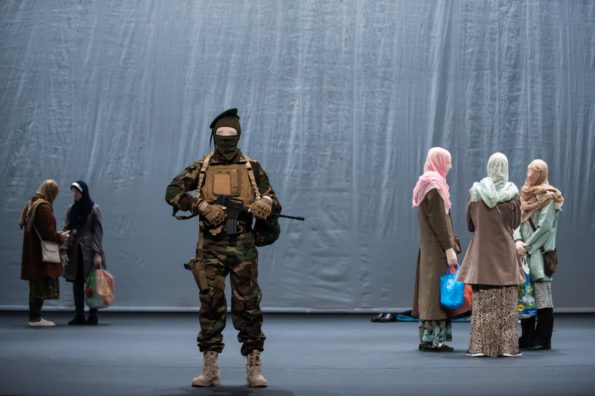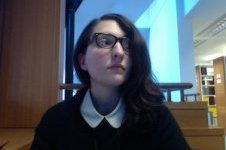Search
To search for an exact match, type the word or phrase you want in quotation marks.
A*DESK has been offering since 2002 contents about criticism and contemporary art. A*DESK has become consolidated thanks to all those who have believed in the project, all those who have followed us, debating, participating and collaborating. Many people have collaborated with A*DESK, and continue to do so. Their efforts, knowledge and belief in the project are what make it grow internationally. At A*DESK we have also generated work for over one hundred professionals in culture, from small collaborations with reviews and classes, to more prolonged and intense collaborations.
At A*DESK we believe in the need for free and universal access to culture and knowledge. We want to carry on being independent, remaining open to more ideas and opinions. If you believe in A*DESK, we need your backing to be able to continue. You can now participate in the project by supporting it. You can choose how much you want to contribute to the project.
You can decide how much you want to bring to the project.

La plaza begins with a floor covered in flowers and candles, commemorating death. The scene changes and we find ourselves facing a square. Almost imperceptibly, this square mutates into other squares and in all of them we discover a concatenation of events. The bodies on stage move slowly, in perfect choreographies. We hear voices, but they are indistinguishable; without words, they are only presences. Words have turned into images, displaced to a projected text that speaks to us in the second person singular. As a spectator, I acquire a character. That’s when we realise that we’re witnessing the last moment of a performance that has lasted 365 days and has taken place simultaneously in 365 places. You find yourself on your way home, walking. You’re wearing earphones, listening to music. As you read about what’s happening along your journey, the successive squares take place on stage and the sound creates an atmosphere for you.

With this gesture, El conde de Torrefiel reveals that the spectator’s gaze is always directed, affected. On the other hand, it suggests a device in which, through a collage, image, word and sound work in parallel but with a degree of independence. As we read and listen to the text, the images succeed one another. The bodies are voiceless and the direct relationship between word and image that usually occupies the stage is broken. In its place, a series of signifiers and meanings are suggested, among which the spectator traces perhaps new connections. The exercise of editing the various elements is left to us.

The journey begins with the slow-moving presence of a soldier watching over a square somewhere in the Middle East, or perhaps somewhere in Europe. This image gradually transforms and leads us to another part of the world or to another moment in time, where we see a group of tourists visiting monuments. A muffled, tacit violence constantly pervades the scene. A normalised violence. As revealed by El conde de Torrefiel, there is violence and memory in all squares: through gestures and customs, embodied in their monuments, connected to the past. These are places in which life is based on the history of the territory narrated in stone. Images of the past that tell a story of violence that becomes social in the present.
La plaza reveals a connection between the Middle East and the West. A connection between bodies. Middle Eastern bodies come to Europe in search of refuge, while European bodies travel around the world for leisure and tourism. Another form of refuge. Just as our gaze is directed and choreographed, so are the movements of our bodies across the planet. Displacements affected by factors that escape our control and our desire, intertwined with the borders that separate countries. Movements on which the world is built, rooted in the depths of the organisation of the sensitive, performed by human bodies but also objects, capital and memories. In a world seen from a bird’s eye view, the traces of these itineraries act as musical scores.
Without wanting to reveal the end of La plaza, all I’ll say is that it concludes with another symbolic image, this one outside the square, at home. It ends with a place of life and death, where the image of the real isn’t born and doesn’t die but falls into a paradox made up of layers of representation and reality. This idea pervades the whole of the installation. The text, for instance, a voice that is at once ours and not ours, tells us how our experience with the real is permeated by representations of the real. We realise how the representation of history is embodied in us through heritage, or how we identify a place in the Middle East, or a future place, through the image of it that has been transmitted to us. In other words, we are spectators of how the performance eventually takes shape. Predetermined structures that we repeat across all countries, every day of the year. The choreographies danced by our bodies, suffering bodies, migrant bodies, gendered bodies. Above all this, bodies dependent on screens and the information these move all over the planet.
To speak of screens means to speak of images. These appear to be immaterial, martyrs of simulacrum. It would seem as if, having lost their bodies, they had swept us along with them to inhabit a virtual world where representation has taken control of reality, and therefore of all capacity for action of subjects. Quite the contrary — images haven’t lost their bodies, they have simply changed them. They are made up of the work (of the body insofar as it consists of hours of life) of those who extract minerals like coltan, which is used to make screens.
Another bird’s eye look will show us the trajectories of the exploitation of mining areas around the world. Images, bodies and matter move across the planet marking paths and itineraries, leaving traces we can read to understand the layout of the world, its choreography. Curves that relate the movements of bodies in the basin of the Orinoco or the Congo to the movements of bodies shopping for the latest iPhone. Then we’ll bring movement to this iPhone, to these screens, through our trips to Dubai or, in the future, back to the city of Palmira. Mineral bodies we quickly cast aside and that end up in a technological cemetery in Ghana, for instance.
Digital images may seem immaterial but they have a very specific origin in the real, and a very visible and heavy body. Yet they’re not only made of the body of telecommunications, they also consist of increasingly complex codes that move mass networks of information. They’re capable of compiling data that is subsequently analysed by algorithms and returned in the form of visibility, through the segmentation of the information we see on our screens, for instance. In other words, through the images we consume. Through the screens, financial rhythms disseminate images that act as musical scores of our movements and are embodied in us. This is why, unlike El conde de Torrefiel, I don’t believe thatreality is increasingly subjective, emotional or impenetrable. This is only the image projected on us all by the screens of this algorithmic framework, which conceals a reality that is in fact quite the opposite. The 2.0 web and its digital squares are based on generating a distorted experience of the social, and based too on the emotional dependency of our digital persona with a non-existent social network. Fortunately, images and reality do exist beyond social media and their algorithmic arrangement. It’s important to bear this in mind when we suffer the depression caused by belief in hyper-reality.
As mentioned in La plaza, we are governed by images of the past, but there are also protocols that want to govern our future from the present. Algorithms have a capacity for prediction; they are capable of calculating our activity and predicting our future activities. The algorithmic distribution of visibility is based on this prediction and is therefore responsible for shaping our future activities by controlling the images of the present. They now try to mark the rhythm to which our bodies will dance. We could say that the musical score of the movements caused by data flow at once generates and conceals the greatest choreography of our present, understanding choreography in a restrictive sense, as a series of closed and predetermined movements we reproduce.
Thus, the images are no longer about movement, they are in themselves movement: they are interfaces that conceal protocols of data movement. The representation of a body descending a staircase that we would behold, completely still, in film, drama or painting is a thing of the past. Moving information, and bodies with it, is the main purpose of screens. As we watch La plaza we write a tweet, send a message on Facebook to a friend living on the other side of the globe, and add a screen capture in real time. We move data that subsequently return to us in the form of ideology: musical scores on tourist destinations, or press articles, or recommendations on future cultural events that Facebook believes may interest us. If monuments used to be erected as ideologies for citizens of the future, today there are digital images aimed at condensing that future moment in the present. In other words, that want to make the future disappear because it is already happening here and now, as we’ve seen with Cambridge Analytica.
La plaza then makes me ask myself in which ways does the image break out of the repetitions our bodies make of the musical scores written by algorithms and which are supported by the distribution of work at a global scale. Do images have the possibility of liberating movements, of generating a certain eventuality within these choreographies of financial rhythms? Of generating movements with which to leave this dance room that are the segmentations of consumption and ways of life? With which to think of other rhythms for our subjectivity, other futures? In spite of appearances, bodies haven’t transformed into data. Nor have digital images; they have a body that fasten them to the material, rooting them to territory. Moreover, they obey their own powerful arcane genealogy that is inevitably invoked.
If even in spite of this we do not trust in the possibilities that dwell in images, it’s important to know that not all algorithmic protocols are the same and that decentralised protocols and algorithms are also being created. Furthermore, mathematical operations are opening up new forms of abstraction, new spaces that for the time being transcend human understanding and control. This implies that mathematical distribution isn’t closed but is organic, and that there is a space for eventuality in which new forms of infinity, for instance, are being written. This field, that is still unknown, will gradually become a part of the cognoscible, and images will no doubt play a part in the task of articulating it for us insofar as they are language. Eventuality exists in the present and in new forms of the future that are being developed, precisely in the frameworks concealed behind digital images. For this reason, neither subjects nor images are trapped in an unsolvable paradox between the virtual and the real. Some time soon it will be images that will make these new forms of future comprehensible. Forms that can generate new ways of control and distribution, of choreographies for bodies, objects, capital and memories, but can also generate ways of escape.
* Images: La plaza, El conde de Torrefiel.
Via https://www.kfda.be/en/program/la-plaza

Virginia Lázaro Villa, lives in London, she is an artist and art critic and what she’s most interested in is iconoclasm and the destruction of things in general. She’s co-directed since 2015 the contemporary art magazine and platform Nosotros and for a while now has worked writing for different media and magazines, as well as doing a few other odd jobs that bring in the real money.
"A desk is a dangerous place from which to watch the world" (John Le Carré)